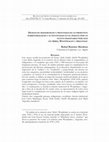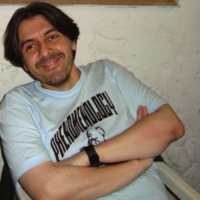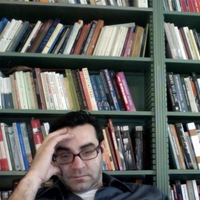Papers by Rafael Ramírez Mendoza
Dando cuenta: estudios sobre el testimonio de la violencia política en el Perú (1980-2000). Eds. Francesca Denegri and Alexandra Hibbett. Lima: Fondo Editorial de la Pontificia Universidad Católica del Perú, 2016. 211-236, 2016

This essay examines the positions of Xavier Abril, Emilio Adolfo Westphalen, and José María Argue... more This essay examines the positions of Xavier Abril, Emilio Adolfo Westphalen, and José María Arguedas in the context of the discussions of the avant-garde, indigenismo and socialism that sought the renewal of the Peruvian imaginary between 1925 and 1940. The framework of the analysis intends to capture the complexity of the influences of José Carlos Mariátegui’s discourse in the debate, abandoning the contrast of the "Andean" and "West" categories and proposing a reading that emphasizes three other premises: authenticity, territoriality and modernity. In this sense, this work examines the relationship between Abril and Westphalen (1930-34), showing their image of Lima as a primitive space and a cultural wasteland in contrast to Europe and studying, among other texts, an unpublished manifesto. This paper then addresses the intellectual relationship between Westphalen and Arguedas at the end of the thirties, showing how their representation of Lima as a hostile place was complemented by the proposal of an indigenous subject capable of the artistic modernity. This mapping of Lima’s cultural scene of the time will explain how, according to these intellectuals, being primitive or modern depended on the authenticity of the artistic/intellectual pursuit.
Editorial Work by Rafael Ramírez Mendoza

The forty-third volume of Mester has two components: a dossier on the subject of violence and a s... more The forty-third volume of Mester has two components: a dossier on the subject of violence and a section of general interest.
This issue of Mester offers the reader a dossier with three articles and one interview dedicated to the theme of violence. To start, Fernanda Alves do Nascimento Andrade analyzes Marçal Aquino’s story “Matadores,” which portrays the world of the assassins on the border between Brazil and Paraguay. The author explores how Aquino represents the norms of this underworld and the relationships between the gunmen, violence and death via the construction of the story’s point of view and a variety narrative strategies. Next, Magdalena Matušková’s article studies two texts by Reinaldo Arenas: El central and Arturo, la estrella más brillante. Matušková explains that during revolutionary Cuba, the Military Units to Aid Production (UMAPs) reproduced the historic abuse and oppression of the plantation system. The author proposes that Arenas denounces the modern-day slavery that young people and homosexuals were subjected to in the UMAPs, not only comparing it to its historical precedents, but also offering strategies that successfully undermine the revolutionary biopolitical discourse that justified it.
Victor Quiroz Ciriaco then highlights how Julio Ortega’s Adiós Ayacucho evolves from the fictionalization of the Archive to its carnivalization within the context of Peru’s internal armed conflict. In his analysis of the construction of the novel’s protagonist—a Quechua-speaking peasant accused of terrorism and assassinated by members of the Peruvian police, who returns from the dead to demand justice from the State—Quiroz shows how Adiós Ayacucho subverts social hierarchies in order to reveal the possibility of Peruvian society’s regeneration. This dossier concludes with an interesting interview with Professor John Patrick Thompson about the memorialization of trauma in contemporary Spain.
Mester’s general interest section opens with an article by Natalia Bieletto that addresses the representation of the carpas shows in Mexico City between 1890 and 1930. The fruit of an extensive archival work, Bieletto’s essay shows how local authorities tried to protect the urban space that they sought to modernize against those who were imagined and discursively constructed as “the poor.”
Next, we offer a facsimile reproduction of a little-known manuscript by the most important Latin American surrealist poet, César Moro. The document, held by the Getty Research Institute, is a 1941 surrealist letter/visual poem from Moro to Peruvian poet Emilio Adolfo Westphalen. We publish it accompanied by a transcription and its corresponding translation from French into Spanish.
Following Moro’s text are two interviews: one with Puerto Rican writer Eduardo Lalo, in which he considers in depth his award-winning novel Simone, and another one with Professor Victor Vich, who discusses the “deculturalization” of culture. This section closes with ten book reviews that examine important works recently published in the United States, Spain, England, and Chile.
Párrafo Magazine, Apr 2014
Párrafo Magazine is the trilingual creative magazine run by the graduate students of the UCLA Dep... more Párrafo Magazine is the trilingual creative magazine run by the graduate students of the UCLA Department of Spanish and Portuguese. Edited by Rafael Ramírez Mendoza, this issue of Párrafo is dedicated to the city of Los Angeles.
Párrafo No. 6 includes texts by Deborah Aguilar Escalante, Sesshu Foster, Alberto Fuguet, Pere Gimferrer, Vinicius Jatobá, Román Luján, Nylsa Martínez, José Luiz Passos, Anthony Seidman, Vickie Vértiz, and Maite Zubiaurre.
The Los Angeles Issue also features photos and artwork by Ryan Allan, Daniel González, Jean-Paul deGuzman, Mario de la Iglesia, Román Luján, Vinícius Praxedes, Johnny Taylor, Noah “Kast” Teran, and Elizabeth Warren.
Antología de la poesía del modernista peruano José Santos Chocano preparada para la colección de ... more Antología de la poesía del modernista peruano José Santos Chocano preparada para la colección de divulgación popular "Perú Lee"
Calidoscopio. Revista Literaria, Nov 2005
Segundo número de Calidoscopio, revista literaria dirigida grupalmente por un comité editorial co... more Segundo número de Calidoscopio, revista literaria dirigida grupalmente por un comité editorial conformado por estudiantes de literatura de la Universidad Nacional Federico Villarreal. Incluye un dossier en homenaje al poeta Wáshington Delgado con textos inéditos (dos poemas y una reflexión sobre la poesía) y una conferencia del autor sobre el Quijote. El dossier incluye también textos de Jorge Puccinelli, Oswaldo Reynoso, Jorge Eslava, Alonso Rabí do Carmo y Rafael Ramírez Mendoza. La sección general incluye un cuento de César Aira, y textos de Alberto Valencia, Juan Manuel Chávez, Carlos Morales, Franco López y Fernando Iwasaki. Reseñas por Francisco Rojas, Carlos Morales y Rafael Ramírez Mendoza
Reviews by Rafael Ramírez Mendoza
Review of Laura Batticani's Escarbaba. Calidoscopio No 2 2005
Review of Cuan impunemente se esta uno muerto by Washington Delgado, published in Identidades, cu... more Review of Cuan impunemente se esta uno muerto by Washington Delgado, published in Identidades, cultural section of the newspaper El Peruano
Interviews by Rafael Ramírez Mendoza
Mester 42 (2013): 117-130, 2013
La directora peruana Claudia Llosa se dio a conocer al mundo cinéfilo con su ópera prima Madeinus... more La directora peruana Claudia Llosa se dio a conocer al mundo cinéfilo con su ópera prima Madeinusa (2006), la cual le valió no sólo el buen recibimiento de la crítica sino también la obtención de diversos premios en Perú, Chile, Holanda, Cuba y Estados Unidos. Pero sería su siguiente película, La teta asustada (2009), la que le otorgaría sus mejores galardones (entre ellos, el Oso de Oro del Festival de Berlín 2009) y su reconocimiento mundial con la nominación a los Óscar 2010 en la categoría de Mejor Película Extranjera.
Translations by Rafael Ramírez Mendoza
Facsimile reproduction of a little-known manuscript by the most important Latin American surreali... more Facsimile reproduction of a little-known manuscript by the most important Latin American surrealist poet, César Moro. The document is a 1941 surrealist letter/visual poem from Moro to Peruvian poet Emilio Adolfo Westphalen. Published accompanied by a transcription and its corresponding translation from French into Spanish (by Paul Cella, Rafael Ramírez Mendoza, and Hélène Roy). With an introduction by Rafael Ramírez Mendoza.
Reproducción facsimilar de un manuscrito poco conocido del más importante poeta surrealista latinoamericano, César Moro. El texto es una carta surrealista/poema visual que Moro le dirigió al poeta peruano Emilio Adolfo Westphalen en 1941. Se publica acompañado de una transcripción y su correspondiente traducción del francés al español (por Paul Cella, Rafael Ramírez Mendoza y Hélène Roy). Con una introducción por Rafael Ramírez Mendoza.
Translation (with Elizabeth Warren).
Other Publications by Rafael Ramírez Mendoza
Post en Párrafo 451, blog de la revista Párrafo Magazine, desvelando la verdadera fecha de nacimi... more Post en Párrafo 451, blog de la revista Párrafo Magazine, desvelando la verdadera fecha de nacimiento del poeta peruano César Moro, y publicando por primera vez su partida de nacimiento. Se corrige además una errata del poema "Viaje hacia la Noche" reproducida en todas las ediciones de la poesía de Moro.
Blog post about Martin Adan and his relationship with Allen Ginsberg and Roberto Bolano
Blog post con una semblanza del narrador peruano Oswaldo Reynoso
Coloquio Internacional sobre la obra de Washington Delgado, 2007
Presentación en Coloquio Internacional en Homenaje a Wáshington Delgado sobre los textos narrativ... more Presentación en Coloquio Internacional en Homenaje a Wáshington Delgado sobre los textos narrativos del poeta peruano
Talks by Rafael Ramírez Mendoza











Uploads
Papers by Rafael Ramírez Mendoza
Editorial Work by Rafael Ramírez Mendoza
This issue of Mester offers the reader a dossier with three articles and one interview dedicated to the theme of violence. To start, Fernanda Alves do Nascimento Andrade analyzes Marçal Aquino’s story “Matadores,” which portrays the world of the assassins on the border between Brazil and Paraguay. The author explores how Aquino represents the norms of this underworld and the relationships between the gunmen, violence and death via the construction of the story’s point of view and a variety narrative strategies. Next, Magdalena Matušková’s article studies two texts by Reinaldo Arenas: El central and Arturo, la estrella más brillante. Matušková explains that during revolutionary Cuba, the Military Units to Aid Production (UMAPs) reproduced the historic abuse and oppression of the plantation system. The author proposes that Arenas denounces the modern-day slavery that young people and homosexuals were subjected to in the UMAPs, not only comparing it to its historical precedents, but also offering strategies that successfully undermine the revolutionary biopolitical discourse that justified it.
Victor Quiroz Ciriaco then highlights how Julio Ortega’s Adiós Ayacucho evolves from the fictionalization of the Archive to its carnivalization within the context of Peru’s internal armed conflict. In his analysis of the construction of the novel’s protagonist—a Quechua-speaking peasant accused of terrorism and assassinated by members of the Peruvian police, who returns from the dead to demand justice from the State—Quiroz shows how Adiós Ayacucho subverts social hierarchies in order to reveal the possibility of Peruvian society’s regeneration. This dossier concludes with an interesting interview with Professor John Patrick Thompson about the memorialization of trauma in contemporary Spain.
Mester’s general interest section opens with an article by Natalia Bieletto that addresses the representation of the carpas shows in Mexico City between 1890 and 1930. The fruit of an extensive archival work, Bieletto’s essay shows how local authorities tried to protect the urban space that they sought to modernize against those who were imagined and discursively constructed as “the poor.”
Next, we offer a facsimile reproduction of a little-known manuscript by the most important Latin American surrealist poet, César Moro. The document, held by the Getty Research Institute, is a 1941 surrealist letter/visual poem from Moro to Peruvian poet Emilio Adolfo Westphalen. We publish it accompanied by a transcription and its corresponding translation from French into Spanish.
Following Moro’s text are two interviews: one with Puerto Rican writer Eduardo Lalo, in which he considers in depth his award-winning novel Simone, and another one with Professor Victor Vich, who discusses the “deculturalization” of culture. This section closes with ten book reviews that examine important works recently published in the United States, Spain, England, and Chile.
Párrafo No. 6 includes texts by Deborah Aguilar Escalante, Sesshu Foster, Alberto Fuguet, Pere Gimferrer, Vinicius Jatobá, Román Luján, Nylsa Martínez, José Luiz Passos, Anthony Seidman, Vickie Vértiz, and Maite Zubiaurre.
The Los Angeles Issue also features photos and artwork by Ryan Allan, Daniel González, Jean-Paul deGuzman, Mario de la Iglesia, Román Luján, Vinícius Praxedes, Johnny Taylor, Noah “Kast” Teran, and Elizabeth Warren.
Reviews by Rafael Ramírez Mendoza
Interviews by Rafael Ramírez Mendoza
Translations by Rafael Ramírez Mendoza
Reproducción facsimilar de un manuscrito poco conocido del más importante poeta surrealista latinoamericano, César Moro. El texto es una carta surrealista/poema visual que Moro le dirigió al poeta peruano Emilio Adolfo Westphalen en 1941. Se publica acompañado de una transcripción y su correspondiente traducción del francés al español (por Paul Cella, Rafael Ramírez Mendoza y Hélène Roy). Con una introducción por Rafael Ramírez Mendoza.
Other Publications by Rafael Ramírez Mendoza
Talks by Rafael Ramírez Mendoza
This issue of Mester offers the reader a dossier with three articles and one interview dedicated to the theme of violence. To start, Fernanda Alves do Nascimento Andrade analyzes Marçal Aquino’s story “Matadores,” which portrays the world of the assassins on the border between Brazil and Paraguay. The author explores how Aquino represents the norms of this underworld and the relationships between the gunmen, violence and death via the construction of the story’s point of view and a variety narrative strategies. Next, Magdalena Matušková’s article studies two texts by Reinaldo Arenas: El central and Arturo, la estrella más brillante. Matušková explains that during revolutionary Cuba, the Military Units to Aid Production (UMAPs) reproduced the historic abuse and oppression of the plantation system. The author proposes that Arenas denounces the modern-day slavery that young people and homosexuals were subjected to in the UMAPs, not only comparing it to its historical precedents, but also offering strategies that successfully undermine the revolutionary biopolitical discourse that justified it.
Victor Quiroz Ciriaco then highlights how Julio Ortega’s Adiós Ayacucho evolves from the fictionalization of the Archive to its carnivalization within the context of Peru’s internal armed conflict. In his analysis of the construction of the novel’s protagonist—a Quechua-speaking peasant accused of terrorism and assassinated by members of the Peruvian police, who returns from the dead to demand justice from the State—Quiroz shows how Adiós Ayacucho subverts social hierarchies in order to reveal the possibility of Peruvian society’s regeneration. This dossier concludes with an interesting interview with Professor John Patrick Thompson about the memorialization of trauma in contemporary Spain.
Mester’s general interest section opens with an article by Natalia Bieletto that addresses the representation of the carpas shows in Mexico City between 1890 and 1930. The fruit of an extensive archival work, Bieletto’s essay shows how local authorities tried to protect the urban space that they sought to modernize against those who were imagined and discursively constructed as “the poor.”
Next, we offer a facsimile reproduction of a little-known manuscript by the most important Latin American surrealist poet, César Moro. The document, held by the Getty Research Institute, is a 1941 surrealist letter/visual poem from Moro to Peruvian poet Emilio Adolfo Westphalen. We publish it accompanied by a transcription and its corresponding translation from French into Spanish.
Following Moro’s text are two interviews: one with Puerto Rican writer Eduardo Lalo, in which he considers in depth his award-winning novel Simone, and another one with Professor Victor Vich, who discusses the “deculturalization” of culture. This section closes with ten book reviews that examine important works recently published in the United States, Spain, England, and Chile.
Párrafo No. 6 includes texts by Deborah Aguilar Escalante, Sesshu Foster, Alberto Fuguet, Pere Gimferrer, Vinicius Jatobá, Román Luján, Nylsa Martínez, José Luiz Passos, Anthony Seidman, Vickie Vértiz, and Maite Zubiaurre.
The Los Angeles Issue also features photos and artwork by Ryan Allan, Daniel González, Jean-Paul deGuzman, Mario de la Iglesia, Román Luján, Vinícius Praxedes, Johnny Taylor, Noah “Kast” Teran, and Elizabeth Warren.
Reproducción facsimilar de un manuscrito poco conocido del más importante poeta surrealista latinoamericano, César Moro. El texto es una carta surrealista/poema visual que Moro le dirigió al poeta peruano Emilio Adolfo Westphalen en 1941. Se publica acompañado de una transcripción y su correspondiente traducción del francés al español (por Paul Cella, Rafael Ramírez Mendoza y Hélène Roy). Con una introducción por Rafael Ramírez Mendoza.